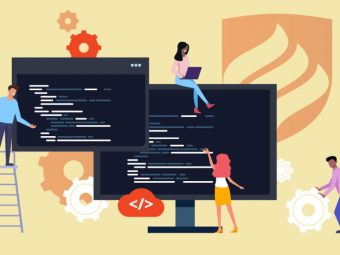Looker Complete Guide To Google Looker User And Analyst
Tags: Google Looker
Use Looker to analyze data, create graphs, and build reports and dashboards with the beginner to expert Looker guide
Last updated 2022-01-10 | 4.4
- Analyze data- create beautiful visualizations
- and build sophisticated reports and dashboards
- Get certified in using Looker as Business Intelligence and Visualization tool
- Get familiar with Looker's platform
- interface
- and terminology
What you'll learn
* Requirements
* No experience necessary; come hungry to learn! This is a beginner to expert courseDescription
Learn from more than 8 hours of relevant instructional video content, with the only complete beginner to expert guide on Google Looker.
Explore, analyze, visualize, and access your data with Google Looker. Looker is used as a sophisticated business intelligence (BI) and visualization software similar to Power BI and Tableau. Companies deploy Looker to their employees so that they can make trusted decisions and actions based on their data.
More than 2,000 organizations use Looker. Looker is named as a Visionary in Gartner's Magic Quadrant.
Looker is officially part of Google Cloud Platform. Google bought Looker in 2020 for more than $2.6 billion. This demonstrates Google's investment that Looker will be the top tier BI and visualization software of choice for companies across the world.
This is the only complete guide to Google Looker for the User / Analyst, from beginner to expert. This course is not only comprehensive (it covers everything you need to know right from the start / beginner level) but is also instructional in nature, meaning that as we learn new concepts, we are also integrating them in the application. Don't just learn concepts, learn how to actually apply them. That also means that whether you are a beginner or expert, there's something for you in this course.
This course is structured in a way that helps you learn all the concepts. For each concept, we first cover it in theory and then apply it using a real life example. We also progressively learn more and more advanced concepts, so that you never feel overwhelmed and can achieve your goals.
Note: this is the User / Analyst series. In this course, we learn everything that a consumer of Google Looker would need to know (topics such as analyzing data, creating reports, creating Looks, creating dashboards, organizing and sharing reports, creating custom fields, etc.). This covers more than 95% of Looker's use cases. In order to learn how to use code to develop Looker, please refer to the Developer / Administrator series instead. Feel free to watch the free preview of the Course Overview, or message me, if you have any questions.
Again, this is the complete guide to Google Looker for the User / Analyst - you won't ever need another course.
This course is the User / Analyst series. However, this is still useful if you're a developer or administrator, as this course is a pre-requisite for the Developer / Administrator series.
What is Looker?
Looker is a business intelligence software and big data analytics platform that organizations use to empower their employees to explore, analyze, and share real-time business analytics and insights. It is part of the Google Cloud Platform after Google acquired Looker for over $2.6 billion.
What makes Looker different?
Looker is regarded as more than an alternative to Power BI or Tableau. It operates 100% on the cloud and is browser-based, which means that no desktop software is required or needs to be managed. It contains a trusted data model, and a language called LookML that allows users to compile data and assign business logic across the organization. It also contains powerful APIs and third-party connectors that are used to create workflows and apps from your data.
What is the User / Analyst Series?
Looker is used by two groups of people:
User / Analyst - these are individuals who would use Looker to analyze data, build and consume reports / dashboards, create report workflows, and manage folders and boards. It is also for those people who are knew to Looker who want to understand how Looker works on the front-end before they start developing it. These are people like data analysts, business analysts, data scientists, product managers, department heads, and executives.
Developer / Administrator - these are individuals who would be responsible for setting up Looker, and have it connect and access the underlying SQL data. These people are the ones responsible for creating the underlying data model in LookML that is used by Users and Analysts. These are people like software developers, IT administrators, and data engineers.
What are the main features of Looker?
Cloud-based - Looker is 100% on the cloud, which has massive benefits like not needing to manage a desktop software, ease of deployment, and streamlined standardized user experiences
Reports and dashboards - perform sophisticated analysis on your raw data and create related reports and dashboards to save and replay your work, with the ability to add custom filters
Curative and user-friendly - Looker is easy to use with its no-code features and helper tools
Data model - Looker lets you create a full data model in LookML that sits atop your raw data, which allows you to define relationships between all your data and standardize metrics
Standardize, unified, and governed business logic - Because of the integrated data model, users always have the most up-to-date definition of business logic
Real-time - Looker connects to your raw data directly; no need to create ETLs on a timely basis and as a result, reports and dashboard are always 100% up-to-date
Workflows, actions and custom application - create workflows that schedule data emails based on time or based on a condition; complex workflows with custom UI can also be made
Partner network - Looker has a wide third-party network allowing you to connect external apps to your reports and dashboards, like Slack or Outlook
Multi-DB support - Looker can be used on any underlying SQL Server (Microsoft SQL server, AWS, BigQuery, etc.), supporting a huge range of SQL dialects
Google - Looker is part of Google Cloud Platform, and has the full backing and investment of a trillion dollar company behind it
Why learn Looker?
Drive more insights - Looker is used to drive smarter outcomes for your organization from better and quicker access to data. It enables users to perform their own analysis, with the flexibility of using any dimension and measures as they see fit.
Create reports and dashboards - easily create sophisticated reports and dashboards with impactful visualizations, and save them for future use. These reports also have drill-down features, allowing users to get more granular data if they need to dig deeper.
Get full access to your data - since Looker is connected directly to your raw data, there is no more information lost in the ETL layer - data as granular as transaction data can be used within Looker
Get hired / increase your employability - Looker is used by more than 2,000 top data-driven organizations for a reason; it enables powerful decision making - learning how to consume and create reports and dashboards is an invaluable skill to boost your pay rate and deliver value
Improve your toolkit - add this to your list of data analyst skills - this is very powerful in conjunction with other data analytic and business intelligence skills
Why choose this course?
Complete guide - this is the 100% start to finish, zero to hero, basic to advanced guide on Looker for the User / Analyst. There is no other course like it that teaches you everything from start to finish. It contains over 8 hours of instructional content!
Fully instructional - we not only go through important concepts, but also apply them as we are building our reports and dashboards so that we can solidify them. This is not only a walkthrough of the Looker features, but a course that actually builds with you, so we encourage you to follow along.
Step by step - we go through every single concept in a sequential order (from beginner to expert). This improves your probabilities of learning Looker rather than going haphazardly through each feature.
Learn to learn - during the latter parts of the course, we go through situations where we encounter new features or errors, and work through how we would use the documentation to resolve them. In this way, you not only learn about Looker inside and out, but learn how to resolve your own issues as they come up
Teacher response - if there's anything else you would like to learn, or if there's something you cannot figure out, I'm here for you! Just shoot me a message.
Reference material - follow along! I provide all reference material directly to you so you can follow along in your learning journey
Course overview - User / Analyst
Introduction - learn about Looker, its features, its history with Google, the course overview, and how to succeed in the course
Environment - create a sandbox account, learn about the sample data that we will be using, learn how to load the sample data into Looker, and get familiar with some Looker terminology
Beginner - use Explores to perform analysis on your data, create beautiful visualization that bring your analysis to life, and learn how to save and repeat your analysis using reports called Looks
Moderate - use Filters to make analysis more relevant, create your own fields using Custom Dimensions and Measures, and organize your reports and dashboards with Looker's Sharing and Organization features
Expert - create more sophisticated visualizations (like maps, single values, waterfall, etc.), create dashboards with tiles that link to each other, and manipulate data using advanced Looker expressions
Conclusion - earn your Looker Online certification, and read about next steps
If you want to learn Google Looker as a User / Analyst, then this is the course for you. We're looking forward to having you in the course and hope you earn the certificate.
Music: Bensound
Who this course is for:
- Users of any analytics, business intelligence, or visualization tools
- Data analysts, data scientists, and managers who want to quickly find insights in their data
- Managers who currently use Excel to build reports and dashboards and want a better way
- Analysts who build dashboards for senior audiences, and want to automate that process
Course content
13 sections • 95 lectures








 This course includes:
This course includes:
![Flutter & Dart - The Complete Guide [2022 Edition]](https://img-c.udemycdn.com/course/100x100/1708340_7108_5.jpg)















